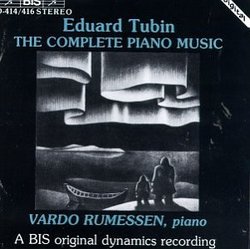| All Artists: Eduard Tubin, Vardo Rumessen Title: Eduard Tubin: The Complete Piano Music Members Wishing: 0 Total Copies: 0 Label: Bis Release Date: 3/25/1994 Album Type: Import Genres: Special Interest, Classical Styles: Marches, Opera & Classical Vocal, Chamber Music, Forms & Genres, Sonatas, Suites, Historical Periods, Classical (c.1770-1830), Modern, 20th, & 21st Century Number of Discs: 3 SwapaCD Credits: 3 UPCs: 750582023323, 7318594144165 |
Search - Eduard Tubin, Vardo Rumessen :: Eduard Tubin: The Complete Piano Music
 | Eduard Tubin, Vardo Rumessen Eduard Tubin: The Complete Piano Music Genres: Special Interest, Classical
|
Larger Image |
CD Details |
CD ReviewsMajor Landmark in the 20th century piano litterature Jean-Baptiste OUDAR | France | 04/13/2000 (5 out of 5 stars) "Tubin 2nd piano sonata is really a huge work. We now know thatTubin is a major symphonist of the 20th century, but this workdemonstrates and emphasizes his stature as a composer. This second piano sonata, composed in 1950, could leave you with the same feeling as Prokofiev's 7th, but this would be superficial as this lies in the overall appearance only: The drama of the outer movements is getting to higher peaks first (for reference his 6th symphony composed at the same period). Secondly, the langage is far more advanced and goes into what I would venture to call a very well mastered free atonalism. The central movement is using Lapland tunes for variations. Again here, we have nothing related to Bartok geometry but, although gloomy at times, a more relaxed atmosphere. The rest of the set must be heard for the complete Preludes which allows the listener to follow Tubin's language evolution during his whole composing life. Lastly for his first piano Sonata which is a quite early work which bears traces of Rachmaninov pianism and the later Scriabin harmonies but already with embryo of his mature and very personal language. The pianist Vardo Rumessen is not only a champion of Tubin chamber music but also a key person in the knowledge we now start to get in the west of the Estonian genious in Art Music. Apart from the expected idiom he can deliver in this field he has a unique perception of Tubin musical drama. This is probably due to his considerable musicologic research he has perfomed with an unparalled energy all along his life. The recorded sound would have better served the works if it had been a little bit closer to my opinion."
|

 Track Listings (19) - Disc #1
Track Listings (19) - Disc #1